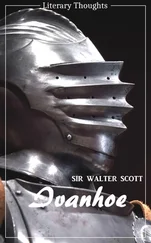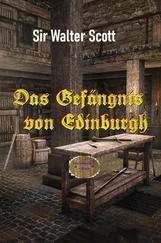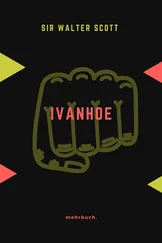Walter Scott - Ivanhoe
Здесь есть возможность читать онлайн «Walter Scott - Ivanhoe» — ознакомительный отрывок электронной книги совершенно бесплатно, а после прочтения отрывка купить полную версию. В некоторых случаях можно слушать аудио, скачать через торрент в формате fb2 и присутствует краткое содержание. Жанр: Исторические приключения, на английском языке. Описание произведения, (предисловие) а так же отзывы посетителей доступны на портале библиотеки ЛибКат.
- Название:Ivanhoe
- Автор:
- Жанр:
- Год:неизвестен
- ISBN:нет данных
- Рейтинг книги:4 / 5. Голосов: 1
-
Избранное:Добавить в избранное
- Отзывы:
-
Ваша оценка:
- 80
- 1
- 2
- 3
- 4
- 5
Ivanhoe: краткое содержание, описание и аннотация
Предлагаем к чтению аннотацию, описание, краткое содержание или предисловие (зависит от того, что написал сам автор книги «Ivanhoe»). Если вы не нашли необходимую информацию о книге — напишите в комментариях, мы постараемся отыскать её.
Ivanhoe — читать онлайн ознакомительный отрывок
Ниже представлен текст книги, разбитый по страницам. Система сохранения места последней прочитанной страницы, позволяет с удобством читать онлайн бесплатно книгу «Ivanhoe», без необходимости каждый раз заново искать на чём Вы остановились. Поставьте закладку, и сможете в любой момент перейти на страницу, на которой закончили чтение.
Интервал:
Закладка:
3 (p. 327) “I accept of no such presents, ” said the Knight: [Author’s note] Richard Cœur-de-Lion. The interchange of a cuff with the jolly priest is not entirely out of character with Richard I., if romances read him aright. In the very curious romance on the subject of his adventures in the Holy Land, and his return from thence, it is recorded how he exchanged a pugilistic favour of this nature while a prisoner in Germany. His opponent was the son of his principal warder, and was so imprudent as to give the challenge to this barter of buffets. The King stood forth like a true man, and received a blow which staggered him. In requital, having previously waxed his hand, a practice unknown, I believe, to the gentlemen of the modern fancy, he returned this box on the ear with such interest as to kill his antagonist on the spot. See in Ellis’s Specimens of English Romance, that of Cœur-de-Lion.
CHAPTER XXXIII
1 (p. 329) epigraph: The lines are from Shakespeare’s Coriolanus (act 1, scene 6).
2 (p. 331) morris-dancer: Here is another example of the historical freedoms Scott allowed himself in Ivanhoe. Like jousting tournaments, morris-dancing is anachronistic to the twelfth century; no records of it appear before the fifteenth century. That said, it is highly apropos to Scott’s themes, as traditional morris-dancing features the characters of Robin Hood, Maid Marian, and Friar Tuck.
3 (p. 332) “Father Aymer, Prior of the rich Abbey of Jorvaulx”: [Author’s note] Jorvaulx Abbey. This Cistercian abbey was situate in the pleasant valley of the river Jore, or Ure, in the North Riding of Yorkshire. It was erected in the year 1156, and was destroyed in 1537. For nearly three centuries, the ruins were left in a state nearly approaching to utter demolition; but at length they were traced out and cleared at the expense of Thomas Earl of Aylesbury, in the year 1807. The name of the abbey occurs in a variety of forms, such as Jorvaulx, Jervaux, Gerveux, Gervaulx, Jorvall, Jorevaux, etc. In Whitaker’s History of Richmondshire, vol. i., a ground-plan of the building is given, along with notices of the monuments of the old abbots and other dignitaries which are still preserved (Laing).
4 (p. 335) Ichabod! … my house!: Ichabod means “without glory.” See the Bible, 1 Samuel 4:21.
5 (p. 340) “Thou be’st a hedge-priest”: [Author’s note] Hedge-Priests. It is curious to observe, that in every state of society some sort of ghostly consolation is provided for the members of the community, though assembled for purposes diametrically opposite to religion. A gang of beggars have their patrico, and the banditti of the Apennines have among them persons acting as monks and priests, by whom they are confessed, and who perform mass before them. Unquestionably, such reverend persons, in such a society, must accommodate their manners and their morals to the community in which they live; and if they can occasionally obtain a degree of reverence for their supposed spiritual gifts, are, on most occasions, loaded with unmerciful ridicule, as possessing a character inconsistent with all around them.
Hence the fighting parson in the old play of Sir John Oldcastle, and the famous friar of Robin Hood’s band. Nor were such characters ideal. There exists a monition of the Bishop of Durham against irregular churchmen of this class, who associated themselves with Border robbers, and desecrated the holiest offices of the priestly function, by celebrating them for the benefit of thieves, robbers, and murderers, amongst ruins and in caverns of the earth, without regard to canonical form, and with torn and dirty attire, and maimed rites, altogether improper for the occasion.
CHAPTER XXXIV
1 (p. 342) epigraph: The lines are from Shakespeare’s King John (act 3, scene 3).
2 (p. 343) Ahithophel: Ahithophel was a co-conspirator with Absalom against his father, King David, in the Bible, 2 Samuel 15-17.
3 (p. 344) bloody … with speed: The quotation, slightly altered, is from Shakespeare’s Richard II (act 2, scene 3) .
4 (p. 348) Thomas-a-Becket … stained the steps of his own altar: The most notorious event of Henry II’s largely beneficent reign was the murder, at his suggestion, of his erstwhile friend Thomas à Becket, archbishop of Canterbury, in 1170. After Thomas’s elevation to sainthood three years later, Canterbury Cathedral, site of the killing, became a destination for pilgrims and is perhaps the most famous of England’s holy places. Waldemar Fitzurse, Prince John’s counselor in Ivanhoe, is a fictional son of one of Thomas’s murderers, Reginald Fitzurse.
5 (p. 348) Tracy, Morville, Brito: [Author’s note] Slayers of Becket. Reginald Fitzurse, William de Tracy, Hugh de Morville, and Richard Brito were the gentlemen of Henry the Second’s household who, instigated by some passionate expressions of their sovereign, slew the celebrated Thomas-a-Becket.
CHAPTER XXXV
1 (p. 350) epigraph: The lines are written by Scott himself.
2 (p. 351) “we visit the preceptories”: [Author’s note] Preceptories. The establishments of the Knights Templars were called preceptories, and the title of those who presided in the order was preceptor ; as the principal Knights of St. John were termed commanders, and their houses commanderies. But these terms were sometimes, it would seem, used indiscriminately.—Such an establishment formerly existed at Temple Newsam, in the West Riding, near Leeds (Laing) .
3 (p. 352) fiery furnace seven times heated: See the Bible, Daniel 3:19.
4 (p. 355) Ut leo semper feriatur: The Latin translates as “The lion must always be struck down.” [Author’s note follows] Ut Leo Semper Feriatur. In the ordinances of the Knights of the Temple, this phrase is repeated in a variety of forms, and occurs in almost every chapter, as if it were the signal-word of the order; which may account for its being so frequently put in the Grand Master’s mouth.
5 (p. 357) “Take to thee the brand of Phineas”: The Grand Master refers to a grisly incident in the Bible (Numbers 25:7-8) and a symbolic biblical indictment of interracial sex that is pertinent to the case of Rebecca and Bois-Guilbert. Phineas, on finding an Israelite soldier sleeping with a Midianite woman, slays them both with a single thrust of his spear.
6 (p. 360) the thrashing-floor: See Matthew 3:12.
7 (p. 360) Vinum … pulchritudine tua: The first phrase quotes the Bible, Psalm 104:15: “Wine that maketh glad the heart of man.” The second derives from Psalm 45:11, “So shall the king greatly desire thy beauty” (KJV).
CHAPTER XXXVI
1 (p. 363) epigraph: The lines are written by Scott himself.
CHAPTER XXXVII
1 (p. 371) epigraph: The lines are written by Scott himself.
2 (p. 383) trial by combat: In a recent article, Gary Dyer has uncovered a contemporary context for Scott’s evocation of this Norman law, which allows the accused to defend themselves, if proxy by necessary, in single combat; the belief was that God would justly decide the outcome of the contest, revealing the truth of the case in a manner beyond human divination. In 1817 Britons were amazed to learn that the law of combat was still on the books when Abraham Thornton, accused of the murder of Mary Ashford, invoked his defendant’s chivalric right. The case against Thornton broke down in confusion, and the trial was widely reported. See Gary R. Dyer, “Ivanhoe, Chivalry, and the Murder of Mary Ashford,” Criticism 39 ( 1997) , pp. 383-408.
Читать дальшеИнтервал:
Закладка:
Похожие книги на «Ivanhoe»
Представляем Вашему вниманию похожие книги на «Ivanhoe» списком для выбора. Мы отобрали схожую по названию и смыслу литературу в надежде предоставить читателям больше вариантов отыскать новые, интересные, ещё непрочитанные произведения.
Обсуждение, отзывы о книге «Ivanhoe» и просто собственные мнения читателей. Оставьте ваши комментарии, напишите, что Вы думаете о произведении, его смысле или главных героях. Укажите что конкретно понравилось, а что нет, и почему Вы так считаете.








